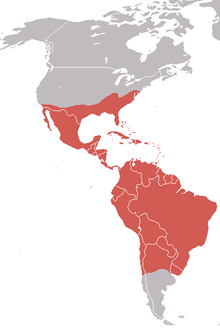| Black vulture | |
|---|---|

| |
| C. a. brasiliensis Peten, Guatemala | |
| Scientific classification | |
| Domain: | Eukaryota |
| Kingdom: | Animalia |
| Phylum: | Chordata |
| Class: | Aves |
| Order: | Accipitriformes |
| Family: | Cathartidae |
| Genus: | Coragyps |
| Species: | C. atratus
|
| Binomial name | |
| Coragyps atratus (Bechstein, 1793)
| |
| Subspecies | |
| |

| |
| Approximate range of the black vulture (note: range throughout the West Indies is erroneous)[image reference needed] | |
| Synonyms | |
|
Vultur atratus Bechstein, 1793 | |
The black vulture (Coragyps atratus), also known as the American black vulture, Mexican vulture, zopilote, urubu, or gallinazo, is a bird in the New World vulture family whose range extends from the southeastern United States to Perú, Central Chile and Uruguay in South America. Although a common and widespread species, it has a somewhat more restricted distribution than its compatriot, the turkey vulture, which breeds well into Canada and all the way south to Tierra del Fuego. It is the only extant member of the genus Coragyps, which is in the family Cathartidae. Despite the similar name and appearance, this species is not closely related to the Eurasian black vulture, an Old World vulture, of the family Accipitridae (which includes raptors like the eagles, hawks, kites, and harriers). For ease of locating animal corpses (their primary source of sustenance), black vultures tend to inhabit relatively open areas with scattered trees, such as chaparral, in addition to subtropical forested areas and parts of the Brazilian pantanal.
With a wingspan of 1.5 m (4.9 ft), the black vulture is an imposing bird, though relatively small for a vulture, let alone a raptor. It has black plumage, a featherless, grayish-black head and neck, and a short, hooked beak. These features are all evolutionary adaptations to life as a scavenger; their black plumage stays visibly cleaner than that of a lighter-colored bird, the bare head is designed for easily digging inside animal carcasses, and the hooked beak is built for stripping the bodies clean of meat. The absence of head feathers helps the birds stay clean and remain (more or less) free of animal blood and bodily fluids, which could become problematic for the vultures and attract parasites; most vultures are known to bathe after eating, provided there is a water source.[2] This water source can be natural or man-made, such as a stream or a livestock water tank.
The black vulture is a scavenger and feeds on carrion, but will also eat eggs, small reptiles, or small newborn animals (livestock such as cattle, or deer, rodents, rabbits, etc.), albeit very rarely. They will also opportunistically prey on extremely weakened, sick, elderly, or otherwise vulnerable animals. In areas populated by humans, it also scavenges at dumpster sites and garbage dumps. It finds its meals by using its keen eyesight or following other (New World) vultures, which all possess a keen sense of smell. Lacking a syrinx—the vocal organ of birds—its only vocalizations are grunts or low hisses. It lays its eggs in caves, in cliffside rock crevasses, dead and hollow trees, or, in the absence of predators, on the bare ground, generally raising two chicks each year. The parents feed their young by regurgitation from their crop, an additional digestive organ unique to birds, used for storing excess food; their “infant formula”, of sorts, is thus called “crop milk”. In the United States, the vulture receives legal protection under the Migratory Bird Treaty Act of 1918. This vulture also appeared in Mayan codices.
- ^ BirdLife International (2016). "Coragyps atratus". IUCN Red List of Threatened Species. 2016: e.T22697624A93624950. doi:10.2305/IUCN.UK.2016-3.RLTS.T22697624A93624950.en. Retrieved November 19, 2021.
- ^ "Turkey vulture". State of Indiana Government. State of Indiana. August 4, 2022. Retrieved March 13, 2023.
